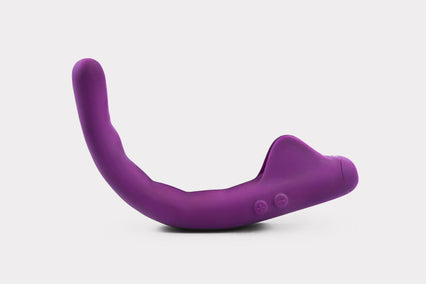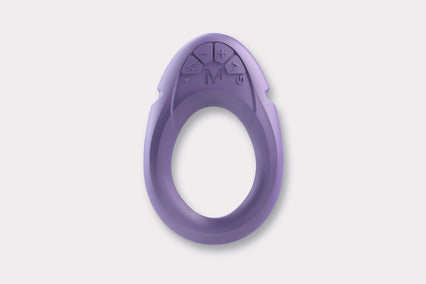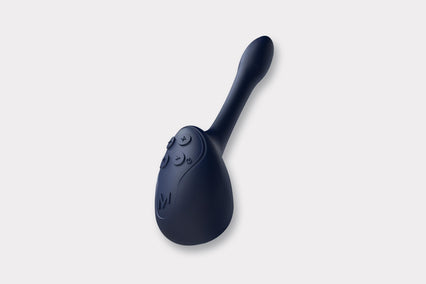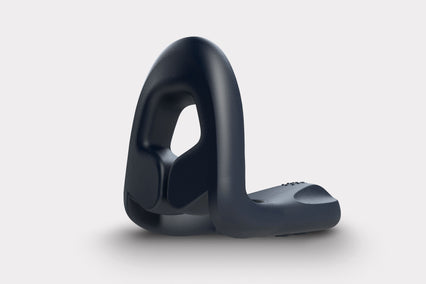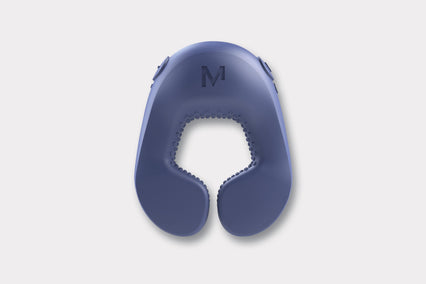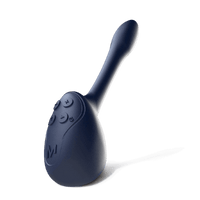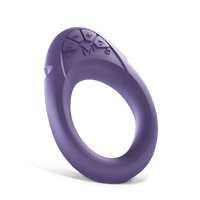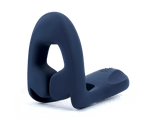Written by: Goh!ddess
So, you’ve heard about this magical ancient practice that seems to multiply orgasms and naturally boost your libido - and you want in.
Or, maybe, you’re more interested in the notion that you can actually twist a penis inside of you using only your vagina, and now nothing will stop you on your quest to become the ultimate sex goddess.
Well, you’re in luck.
In this article, we’ll break down what pompoir is, who it is for, and how you can get started on your vaginal Olympic gymnast journey.
The science behind how pompoir works
Developing a pompoir training schedule
Post-workout pelvic floor stretching
Training tools to learn pompoir
First things first.
What is pompoir
Pompoir is the practice of utilizing the vaginal muscles to create pleasurable sensations during sex. Some of these abilities include squeezing, pulling, tilting, locking, pulsing, sucking, and twisting a penis, using only the vaginal muscles.
Women who practice pompoir report enhanced libidos, increased orgasm frequency, and a significant boost in pleasure from sex.
Beyond a mindfulness practice, pompoir is more akin to a bodyweight workout, focused on your pelvic floor muscles. A workout you can use to drastically improve your sex life.
In fact, here are some of the science-backed benefits of more basic pelvic floor training regimens:
- Prevention of urinary incontinence, even postpartum
- Improved body image
- Increased frequency of sex
- Increased libido & sexual desire
- Boost in sexual function (arousal and pleasure), also postpartum
Who can do pompoir
Anyone with a vagina can do pompoir exercises! Some students of the practice are in their 70s mastering complex abilities such as wringing and whipping (who’s grandma is this cool?) so age or number of births doesn’t necessarily deter your progress.
Before you begin, it’s recommended that you speak with your gynecologist before starting any sort of pelvic floor training, as some women have what is known as a hypertonic pelvic floor. This means the pelvic floor muscles are overly tense and locked up, and there can be a risk of injury if they are clenched even more.
How to start training pompoir
Alright, let’s get to the main question: how do I start training pompoir?
We’ve outlined everything you need to start learning how to do pompoir on your own in this section, however if you’re the type of person that prefers to follow a training course that guides you through each step with a clearly mapped out route, join The Oh!lympus Program. This fully animated pompoir course teaches women how to master their pelvic floors, including over 27 vaginal techniques, to increase their sex drive and intensify pleasure during penetration.
Now, before learning how to do pompoir, it’s important to have an understanding of the pelvic floor anatomy and the science behind how pompoir works.
The science behind how pompoir works
Pompoir involves using the pelvic floor muscles (sometimes referred to as the vaginal muscles) in a way that creates pleasurable sensations for you and your partner during sex.
Just like any other muscle, your pelvic floor can perform different actions.
To illustrate this, let’s look at a different muscle - the bicep.
When you pick up a heavy bag of groceries, you’re shortening the biceps. And when you put it down, you’re lengthening them. But while you’re holding that bag of groceries in place (say for example, if you’re waiting for the cashier to hand you the receipt) you’re activating the bicep’s stabilizing force.
These three types of contractions also work in the pelvic floor, and it is in the combination of these motions that you’ll create different pompoir techniques.

But that’s not all. For a muscle to grow and be more functional (perform a wider range of actions better) it needs sufficient stimulus.
And generally, performing one single exercise will not be enough to provide this required stimulus.
Going back to our bicep example, the bicep is composed of two heads: the long head, and the short head.
Additionally, you have the brachialis, which while it is not technically part of the biceps, helps with flexing the forearm while performing functional movements such as a bicep curl (or picking up that grocery bag!).
So, to train the biceps in an effective way, you will need to select exercises that target each of these heads and the brachialis effectively.
The same is true for the pelvic floor. A variety of exercises will give you the well-rounded training you need to master abilities like pulsing, twisting, locking, milking, etc.

And once again, that’s not all (muscle science never ends…). We also need to consider concepts such as:
- Fast-twitch muscle fibers vs slow-twitch muscle fibers
- The three mechanisms of hypertrophy: metabolic stress, mechanical tension, and muscle damage
- Muscle SRA curve (Stimulus, Recovery, and Adaptation)
- Strength curves of specific exercises: different exercises will create a stronger contraction either at the beginning, middle, or end of the range of motion
If this is starting to sound a little too science-heavy and not too sexy, don’t worry. You don’t need to know any of this to get started with pompoir.
However, it is good to understand that you’ll be working through the three different planes of the vagina.

The horizontal plane, also known as the transverse plane, is the one that divides the body into top and bottom.
When thinking of the vagina in this way, we can divide it into different vertical levels that you can use independently from each other to stimulate different zones of the vagina and the penis.
Some pompoir abilities that involve independently activating different vertical levels of the vaginal canal are whipping, sucking, and milking.

The sagittal plane, also known as the longitudinal plane, is the one that divides the body into left and right.
This is a helpful visual, because in more advanced practices of pompoir you’ll also learn how to move and stimulate each of your vagina’s lateral walls, independently.
Some pompoir abilities that involve independently activating the left and right side of the vaginal canal are tilting, twisting, and pulsing.

Finally, the frontal or coronal plane divides the body into front and back.
Some of these exercises are more intermediate/advanced pompoir techniques that involve manipulating the front and back walls of the vagina, which include locking, rubbing, and controlling.
Alright - Physiology class dismissed.
It’s time to get practical – how do you actually create a schedule to start learning all these amazing abilities?
Pompoir exercises
Below are a combination of techniques and exercises practiced in the pompoir course The Oh!lympus Program with basic instructions to get you started. We will also be releasing more guides on each specific exercise, so you have a clear step-by-step guide, so stay tuned!
- Strong Contraction: the focus here is on performing a strong lift with your pelvic floor muscles as if you were holding in your pee, and then releasing. This is your basic Kegel, but with a focus on power.
- Long Contraction: the focus here is on endurance and holding the contraction. To do this see if you can hold a strong contraction for at least 10 seconds. You’ll improve over time, and the goal is to maintain proper form throughout the contraction, regardless of how long you can hold for.
- Eccentric Contraction: this is a fantastic technique to quickly improve strength by focusing on the eccentric part (the “relaxing”) of the contraction. We borrow the principle of tempo training from the fitness community here and apply it to vaginal training.
- Speedy Contraction: practicing contractions through different tempos and rhythms is extremely functional because sex always follows varying degrees of speed and intensity. So, the focus here is on putting your muscles to work through different conditions.
- Milking: a proper pompoir technique, this sex exercise not only works the vagina through its full range of motion by making you take notice of each individual level going up and down, but it will also create an insanely pleasurable sensation during penetration.
As you can see, the first few exercises are very basic movements - almost like Kegels, re-imagined.
Breaking them up this way helps you progress twice as fast, because you’re focusing on different aspects of the muscles.
That way, once you get to Milking, you’re able to develop an understanding of the different levels of your vaginal canal that otherwise wouldn’t be possible without a baseline of strength.
And once you can do that, you’ve taken a massive step forward on your pompoir journey. This is when movements like squeezing, tilting, pulsing, wringing, locking, juggling, and even twisting become much more intuitive.
Some women even prefer to stop here. After you master these exercises from the transverse plane, sex will already feel much more enjoyable for you and your partner.
Developing a pompoir training schedule
Creating an optimal pompoir exercise plan is going to be dependent on a few factors: how strong your pelvic floor muscles are already, how familiar you are with basic Kegels, and how much time you actually have in your day.
Nonetheless, if you’re just starting out, we recommend a 3-day split, and 30 minutes of training each day. Five minutes coming from post-workout stretching (more on that below).
We’re going to be releasing more specific articles on each training method as part of this guide, but here is a basic schedule to get started:

At the beginning, these three training styles will be working on the vagina’s transverse plane.
This will help you to first identify and master the different vertical levels of your vagina and get acquainted with strong, full, eccentric, and speedy contractions.
Because once you develop that control, you’ll be able to transition to more complex pompoir techniques in a much faster manner.
Mastering these contractions seems to be the sweet spot where you’ll very quickly notice a change in your sex life, whereas the progress can be much slower for more complex skills.
So don’t be surprised if after just one or two weeks of following this schedule you find that penetration feels a lot more intense, for both you and your partner.
Pompoir breathing
Proper pompoir breathing should follow some basic health guidelines to make sure you align your pelvic diaphragm with your thoracic diaphragm.
The key here is to contract as you exhale, and not as you inhale. This might be a bit counter-intuitive at first, but for those of you who have done yoga or weight training in the past, it’s the same principle.
Take a gentle breath through your nose, and as you exhale, begin the active part of the movement. Then, as you inhale again, relax.
For those exercises where you need to hold a contraction, continue breathing naturally through that clench - never holding your breath.
Post-workout pelvic floor stretching
As women naturally hold a lot of tension in their pelvic floors, it’s important to stretch to prevent this active training from causing any sort of cramping or spasticity.
To do this, take (at least) five minutes after your pompoir practice to stretch your pelvic floor. Completely relax your pelvic floor muscles, putting an end to the practice, and gently adopt the following positions:
- Yogi squat
- Sphinx pose
- Happy baby pose
- Child’s pose
- Frog pose
Stretching will also help with building strength, because it lengthens muscle tissue and increases flexibility, which allows you to perform pompoir exercises through a greater range of motion.
Applying pompoir during sex
Now, you may be thinking - what about sex? When do I apply these concepts in the bedroom?
To that we say, whenever you want!
Generally, after just two weeks of this beginner workout, sex will already feel a lot more pleasurable. And not only penetration-wise. You might find yourself thinking about sex more often, getting aroused faster, and even your non-penetrative orgasms might feel stronger too.
It might take a little bit more time or a little bit less, depending on the person.
Now, when it comes to actively performing these sex exercises in bed, some people prefer training alone during the week, and then saving their pompoir-sex sessions for the weekend where they apply their skills with their partner. However, it’s your sex life, so do it whenever you feel ready to.
Training tools to learn pompoir
Here are some helpful tools and resources to help you alongside your pompoir journey.
The Oh!lympus Program
The Oh!lympus Program is the most comprehensive training course that exists today! This fully-animated pompoir course is a 12-week program that brings out your inner sex goddess, teaching you how to perform every single vaginal technique & transforming your sex life. Packed with beautiful step-by-step exercise animations, a wonderful community, PDF guides, and instructions on how to apply every single technique during sex, this is the most comprehensive, medically-endorsed program to master pompoir and costs $399. Save $100 using this link and start The Oh!lympus Program now.
The Gohddess Method
The Gohddess Method is a comprehensive book the provides everything about how to begin and master the practice of pompoir - from instructions to tutorials. The book provides lessons on how to apply pompoir to your sex life, and for the science nerds, it even goes into detail about the biomechanics science of pompoir. It is available for purchase from Amazon for Kindle or paperback.
Pompoir Book
The Pompoir Book is a digital resource based off the book, “The Fine Art of Pompoir” (see below), that offers online private classes and one-on-one consultations to help you master your pelvic floor with beginner pompoir techniques. The online classes are $300 for a 3-hour long session and the consultation is $100 for a 45-min session. This option may benefit those seeking a more individualized path.
The Fine Art of Pompoir - The Ultimate Guide To Pelvic Fitness
The Fine Art of Pompoir is a book dedicated to learning the art of pompoir containing a breakdown of techniques, a workout plan, and descriptions. While a good resource, if you are more visually inclined, this book does not contain any illustrations or diaphragms about how to perform the exercises. The book focuses more on beginner techniques including squeezing and contracting but doesn't cover any intermediate/advanced pompoir skills like whipping, tilting, pulsing, locking, twisting, etc.
Kegel weights or balls
If you’re having trouble with the beginner workout outlined above, it can be useful to purchase a pelvic floor trainer like Kegel weights or Kegel balls.
On your non-training days (Tuesdays and Thursdays), put them inside of you for up to 3 hours.
This will provide some gentle resistance for your vaginal muscles, and hopefully accelerate your strength-building process.
Vibrators
If you’re really serious about mastering vaginal-Olympic-gymnast levels of pompoir (whipping, wringing, pulsing, shaking, juggling, and twisting a penis to the point of excruciatingly pleasurable, next-level orgasms) then vibrators are your ally. While any vibrator will work, we specifically recommend a bendable vibrator like Crescendo 2.
What makes Crescendo 2 so unique for the practice is the bendable component, which will provide some insightful visual cues for complex exercises, so you understand whether you’re twisting, pulling etc. Crescendo 2’s targeted vibrations can also help you identify the different regions of your vaginal canal
Some vibrators are pelvic floor trainers that come with biofeedback mechanisms, usually smartphone apps, that allows you to see what your pelvic floor is doing. In more extreme instances, such as postpartum or pelvic floor prolapse, these devices might be beneficial for those who need more monitoring. Before investing in any pelvic floor trainer, consult your doctor to make sure the device will not worsen or aggravate any preexisting condition.
Pompoir is an incredible practice that empowers every woman and vulva-owner to have great sex. So, what are you waiting for? Become unforgettable in bed and watch your sex life skyrocket with pompoir. Who could say no to that?

